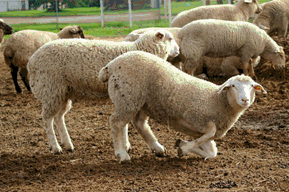| |
Lameness in Sheep 2016 | |
| |
|
|
| |
|
|
| | 2016/2018 - Lameness in Sheep
Lethbridge Research Centre
Despite years of effort, time and money invested there are still limping sheep. Losses in the United Kingdom from foot rot alone cost about £10 per ewe per year, roughly $280 million CDN lost to only one of the causes of lameness. In Alberta lameness contributes to losses in ewe productivity and lamb growth due, to ill health, pain, and poor body condition. In addition to the issues in animal well-being are costs in diagnosis and treatment. Lameness takes toll on flocks and on the people caring for them.

Research has shown a number of reasons for lameness. In the UK 45% of the lame sheep have been diagnosed with ‘scald’, 20% with foot rot, 17% with contagious ovine digital dermatitis (CODD), and a further 18% of assorted conditions (toe granuloma, abscesses, ‘shelly’ hoof).
Despite conscientious efforts by producers and veterinarians around the world control methods haven’t worked. In 2015 samples were taken in Alberta flocks and feed yards. A variety of bacterial infections and management practices were identified as possibly having a role in lameness.
In 2016 Agriculture Canada and the University of Wisconsin, in collaboration with industry stakeholders and funding from ALMA, will lead research into the incidence and characterization of lameness in Alberta flocks and feedlot lambs. With collaborating veterinary practitioners, flock and feed yard owners the project will look at:
- The occurrence of lameness in a small number of lamb feedlots and ewe flocks.
- The environmental and management factors associated with lameness.
- The causative agents and the microbiome associated with lameness.
- The transmission rate of the most prevalent causes of lameness in lamb feed yards.
Research findings will focus on developing science-based information for flock owners, lamb feeders and veterinarians that will assist them in assessing risk factors and in designing strategies for management and treatment.
Project leads
Dr. Schwartzkopf-Genswein, AAFC, Lethbridge Research Centre, AB
Dr. Doepfer, School of Veterinary Medicine, University of Wisconsin, Madison, WI
|
|
| |
|
|
| |
For more information about the content of this document, contact Amrit Matharu.
This information published to the web on July 15, 2016.
|
|